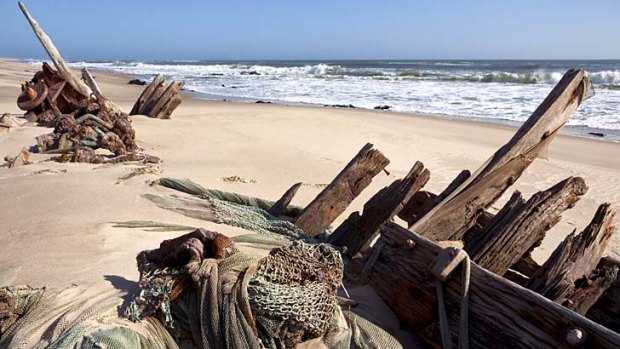
Shipwrecks dot the shore of the Skeleton Coast.Credit: Getty Images
Where the perilous Skeleton Coast meets the world's oldest desert, Michael Gebicki flies from one jaw-dropping wonder to another.
I have sand in my hair, sand in my socks, sand in my mouth, sand up my nose and sand in my ears. My whole world right now is nothing but a sea of sand and a Windex-blue sky. The howling wind of midday has softened to a late-afternoon breeze, yet even this is enough to make the grains hover, blurring my footprints and dissolving the bleached rhino skull at my feet in a soft-focus haze.
I'm on an aerial journey with Skeleton Coast Safaris, operated by the legendary Schoeman brothers. We spend four days hopping across the Namib Desert from one jaw-dropping wonder to the next, and it's totally unlike anywhere else in Africa.
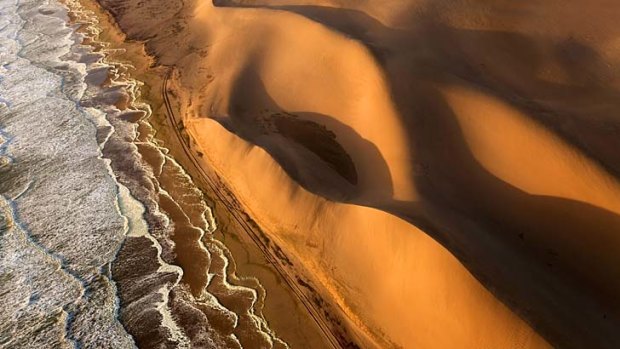
Extreme ... the Skeleton Coast.Credit: Getty Images
Stretching the length of Namibia's coast, this is the world's oldest desert, a scorched wilderness of sand and seared rock. Average annual rainfall would just about cover your thumbnail. It can freeze you to the marrow one day and give you sunstroke the next, yet this desert also has a cinematic majesty.
In its rock gorges you can read the history of planet Earth, its pink dunes contoured with red garnet and dusted with black magnetite. The dunes are the world's highest, topping out at the 390-metre pinnacle of Dune 7 in Sossusvlei.
Inland from the dune sea is a moonscape of deep valleys between rocky hills carved from sedimentary layers that have been lifted and sliced apart by the elements. It is a landscape tailor-made for anyone looking to make a movie that calls for post-apocalyptic scenery. When unseasonal rains greened the desert around Broken Hill last year, the makers of Fury Road, the next Mad Max movie, shifted the location to Namibia.
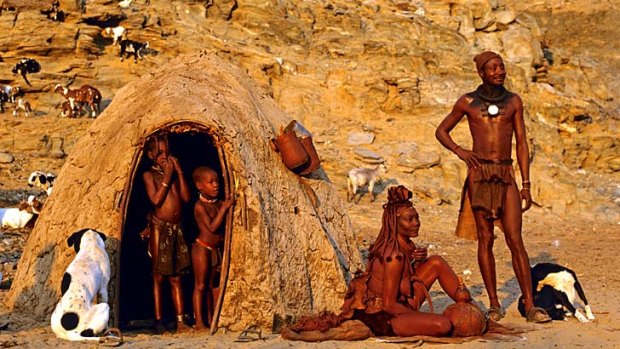
Mud huts of the Himba.Credit: Alamy
My pilot and guide is Bertus Schoeman, one of the brothers operating these safaris. It was their father, Louw Schoeman, a lawyer and passionate conservationist, who first began flying visitors around Namibia, taking them to the camps he established with the help of his sons.
Over the years, Bert has seen and done it all - including ferrying around Brad Pitt when Angelina Jolie chose Namibia as the birthplace for one of the couple's children. The Schoemans now operate regular flying safaris that travel in a giant loop from Windhoek, the capital, to their camps, which lie scattered throughout the country's north. The standard aircraft is the single-engine Cessna 210, a rugged and dependable workhorse with an overhead wing for all-round visibility, and sturdy enough to land on the roughest of airstrips.
Much of our journey takes us along the Skeleton Coast, and this chilling seashore is well named. We first set eyes on it about 90 minutes after leaving Eros Airport in Windhoek. After the rumpled hills of the highlands, we drop over the lip of the escarpment and cross the dunes of the Namib Desert to a thin line of brown, foam-lathered sea and a solid bank of mist stretching into the sky.
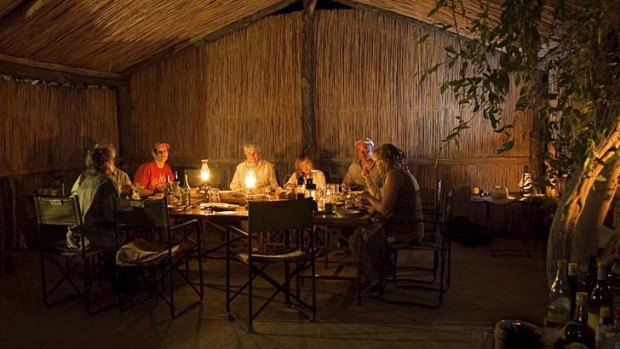
Simple but satisfying ... camp dining.
The cold Benguela Current dredges up chilly waters from deep in the south Atlantic and funnels them north along Namibia's coastline. When it meets the hot, dry air off the Namib Desert, the cold sea forms dense fog banks that rise in a mass along the coast. Combine the fog with a fierce katabatic wind and you have a shoreline tailor-made for maritime disaster, especially in the days when ships were under sail and longitude was a matter of dead reckoning. The San people know it as "The Land God Made in Anger"; to the Portuguese it was "The Gates of Hell".
Several times we fly over rusting ships that are slowly being eaten by sand and waves. Once, we circle low over the strewn timbers and spars of a sailing ship that foundered here, perhaps as early as the 16th century. Neither ships nor their crews were spared from this nautical graveyard.
Even if you made it safely to shore, help lay on the other side of a pitiless desert. Launching a small boat from these steep beaches into the tearing surf would have been impossible, and chances were that your own bleached bones would soon be strewn across the Skeleton Coast.
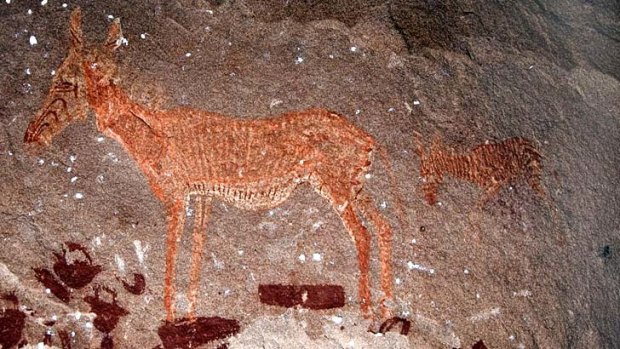
Cave art in Namibia.
The chill, upwelling waters of the Benguela Current also bring with them an explosion of marine life. On our second day out, Bert takes us along the coast once again, flying less than 30 metres off the deck past South African fishermen standing on the edge of the surf. About 100 kilometres north of Swakopmund, we fly low over the Cape Cross fur seal colony, which can number as many as 210,000 seals during summer.
The animals that are associated with southern Africa are either absent or scarce in the parched wastes of the Namib Desert. From time to time we fly over ostriches or a family of zebra. Once, we see a solitary giraffe. In the middle of the night at Kuidas Camp in Damaraland, an oryx munches on the green bush by my tent.
One rarity is the desert-adapted elephant. This is the same species as the elephants that live on the African savannah, but these have been driven to the coast by encroaching human populations who have now created farms and erected fences that prevent them from returning to their natural habitat. Here the elephants have learnt to dig holes in search of water and also to surf the giant dunes on their backsides.
In the folds of the desert's rocks are clues to Namibia's history. Above Kuidas Camp, Bert takes us to a dome-like arrangement of rocks piled against a big boulder. It's a sheepfold, where goatherds would put their animals at night to protect them from lions and hyenas. Bert speculates they are at least several hundred years old.
Higher still, we squeeze through a cleft in the rocks and painted on the cave roof are finely drawn ochre figures of humans and animals, including an antelope that looks like an okapi, a suggestion that this region might once have been forested. These figures are the work of San Bushmen, the hunter-gatherers who were the first inhabitants of this area. Unlike the Bushmen, Bert says, the pastoralists did not make rock art, though they might be responsible for chiselling some of the human figures.
One of the few bits of green in this sun-seared landscape is the occasional Welwitschia mirabilis. Known locally as the tree tumbo and dubbed the world's ugliest plant, it resembles something spewed up from a furnace, a low plant with strappy green fronds writhing away from its blackened core. Welwitschia mirabilis is also a botanical miracle, capturing precious moisture from sea fogs on its leaves while its long tap roots search for underground water. Larger specimens of the plant are believed to be at least 1000 years old.
A highlight of the trip is the encounter with the Himba people. On the third day of the safari we land at a strip close to the Kunene River, which forms the border with Angola.
By Namibian standards, the surroundings are lush. Grass covers the hills, dotted with small families of oryx. After a long ride across the grassland, we dip into the river valley and a small encampment of Himba. Semi-nomadic pastoralists, the Himba follow a traditional lifestyle that has been barely affected by the outside world, living in mud-covered conical huts, hunting and herding goats.
Himba women are famous for their elaborate hair decoration, their jewellery and also for their colouring, which comes from a mixture of ochre and fat that leaves their skin a rich, deep red.
In the middle of one afternoon, we land at a strip carved out by miners at Henties Bay and fire up one of the battered Land Rovers that the Schoemans keep there. "This is where our vehicles come to die," Bert says as we head into the undulating sea of dunes that stretches inland.
It's playtime. "Nervous?" Bert asks as he drives the vehicle skywards until it teeters on the crest of a giant sand wave. It's so steep we can't even see the bottom until the Land Rover tilts downward and it's knees against the dashboard to stop from sliding forward as we glide down in an avalanche of red, rumbling sand that gives them the name "roaring dunes". We spend the next half-hour skiing, rolling and turning somersaults down dunes, until finally the sand between our teeth becomes too much.
The Schoemans' camps are comfortable bush outposts. In the middle of a sun-seared wilderness you get a decent bed in a permanent tent or a proper room, in the case of Leyland's Drift, with sheets, a quilt and a hot-bucket shower. Meals are simple but satisfying and there are always eggs for breakfast and fresh fruit on the table.
If it's contentment you're after, it's hard to beat a canvas chair and a whisky in your hand as dusk purples the African landscape, with a fire adding its crackling beat to the cook singing in the kitchen.
The writer travelled as a guest of Classic Safari Company.
Windhoek in style
In Windhoek, Namibia's capital, Olive Grove rates as a real find — a small guesthouse set around a courtyard garden with charm and heaps of style.
In a quiet, residential part of the city, the property's guest rooms open to spacious verandahs. The central courtyard has an open-air lounge, spa bath and plunge pool as well as a restaurant that offers a choice of indoor or outdoor dining.
Several rungs higher up the luxury ladder, the Garden Suite has two queen-size beds, a fireplace, dining area and infinity pool, set in its own domain surrounded by olive trees. Room rate for two starts from $N1260 ($142) a night. olivegrove-namibia.com.
Trip notes
Getting there
Qantas operates code-share flights with South African Airways from Melbourne (via either Sydney or Perth) and Sydney to Johannesburg. There are onward flights to Windhoek, Namibia's capital. Return flights start from about $2400. qantas.com.au.
Touring there
This year, the four-day Skeleton Coast Safari costs $US6450 ($6220) a person. The price includes all transport from Windhoek, meals and accommodation. skeletoncoastsafaris.com.
More information
1300 130 218, classicsafaricompany.com.au.
Sign up for the Traveller Deals newsletter
Get exclusive travel deals delivered straight to your inbox. Sign up now.